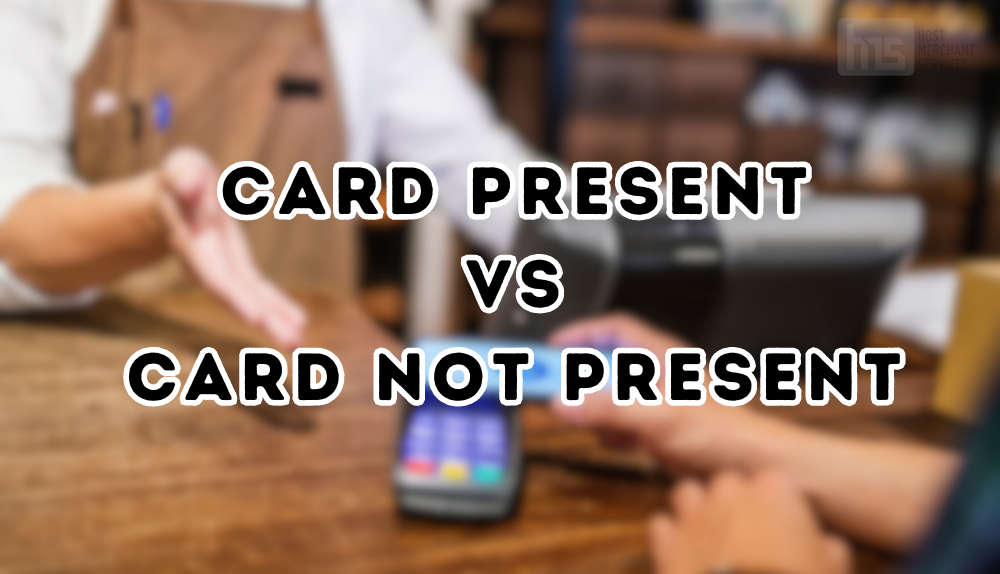
Card Present vs Card Not Present Transactions: What Is The Difference?
- 22nd Jun, 2023
- | By max
- | Uncategorized
In today’s digital age, businesses increasingly offer various payment options to cater to their customer’s diverse needs and preferences. Among these options, Card Present vs Card Not Present (CP Vs CNP) transactions are two key categories that businesses need to understand thoroughly.
Impact of these transactions on processing costs, fraud risks, and customer convenience
For several reasons, understanding the difference between CP and CNP transactions is crucial for businesses. Firstly, these two types of transactions have different processing costs. Generally, CP transactions have lower processing costs due to lower fraud risks, as the card is physically present and can be verified immediately. In contrast, CNP transactions often have higher processing costs due to the increased risk of fraud, as the cardholder’s identity is harder to prove.
The type of transaction can significantly impact the risk of fraud. CP transactions are typically considered more secure as they require physical card verification. However, CNP transactions are more susceptible to fraud as they rely on the customer entering their card details, which can be intercepted or misused.
Choosing CP and CNP transactions can also affect customer convenience. While CP transactions require customers to be physically present, CNP transactions offer the flexibility to make purchases remotely, which can be particularly convenient in situations like the current global pandemic.
Understanding Card Present Transactions
Card Present (CP) transactions refer to those transactions where the customer’s payment card is physically present and can be electronically read at the point of sale. This means the card’s details are captured directly from it by swiping it through a card reader, inserting it into a chip reader, or tapping it on a contactless point-of-sale (POS) terminal.
Examples of CP transactions include:
Swiping the customer’s card through a magnetic stripe reader.
Insert the card into an EMV chip reader.
Tap a contactless card or a mobile device with a digital wallet on a contactless-enabled POS terminal.
Pros and Cons of CP Transactions
CP transactions come with several advantages and disadvantages that businesses need to consider:
Pros:
Lower Processing Costs: CP transactions involve physical card verification, so they have lower fraud risks. As a result, payment processors often charge lower fees for CP transactions than CNP transactions.
Enhanced Security: The requirement for the card to be physically present at the point of sale allows for immediate verification of the card and, in many cases, the cardholder’s identity, thereby reducing the risk of fraudulent transactions.
Cons:
Requirement of Specific Card-Processing Equipment: To accept CP transactions, businesses must invest in card-processing equipment such as card readers or contactless POS terminals. To stay up with advancements in payment technology, this equipment must be continuously updated and maintained, adding to the overall cost.
Understanding Card Not Present Transactions
Card Not Present (CNP) transactions occur when the customer’s payment card is not physically present at the point of sale. This typically happens when the payment is made remotely, such as online or over the phone. In these cases, the card information is manually entered by the customer or the merchant rather than being electronically read from the card itself.
Examples of CNP transactions include:
Online payments are where customers enter their card details on a website or app.
Phone orders where the customer provides their card details over the phone.
Recurring billing services where the customer’s card details are stored and charged periodically.
Pros and Cons of CNP Transactions
CNP transactions also have their own set of advantages and disadvantages:
Pros:
Convenience for Customers: CNP transactions offer a high level of comfort for customers, allowing them to purchase from anywhere at any time. This has become particularly important in the global pandemic, where many customers have shifted towards online shopping.
Cons:
Higher Fraud Risks: Since the card is not physically present at the point of sale, verifying the customer’s identity in CNP transactions is more complicated. This increases the risk of fraud, as criminals may attempt to use stolen card details to make unauthorized purchases.
Higher Processing Fees: Due to the increased risk of fraud, payment processors often charge higher fees for CNP transactions than CP transactions. These higher costs can eat into the profits of businesses, especially those that primarily operate online.
Impact on Processing Costs and Chargeback Liability
The transaction type, whether Card Present (CP) or Card Not Present (CNP), significantly impacts businesses’ processing costs and chargeback liability.
Processing Costs
Processing costs are the fees that businesses pay to their payment processors for handling card transactions. These costs are typically composed of three components: interchange fees, assessment fees, and the processor’s markup.
Interchange Fees: These are fees that the payment processor pays to the card-issuing bank. Interchange fees are usually lower for CP transactions because the risk of fraud is lower. In contrast, CNP transactions have higher interchange fees due to the increased risk of fraud.
Assessment Fees: These are fees that the card networks (like Visa or Mastercard) charge for each transaction. These fees are generally the same for both CP and CNP transactions.
Processor’s Markup: This is the payment processor’s service fee. The markup can vary depending on the type of transaction, with CNP transactions often having a higher markup due to the increased risk and additional security measures required.
Chargeback Liability
Chargebacks happen when a client contests a transaction, which results in the customer receiving their money back. The liability for chargebacks can fall on the merchant or the payment processor, depending on the circumstances.
For CP transactions, the liability often falls on the processor or the card-issuing bank, especially if the merchant has followed all the required procedures for verifying the card and the cardholder’s identity. However, for CNP transactions, the liability often falls on the merchant, as proving the customer’s identity and legitimacy is more challenging.
Interchange Rates for Card Present Vs Card Not Present Transactions
The card networks set interchange rates and are a significant component of the processing costs. As mentioned earlier, these rates are usually lower for CP transactions and higher for CNP transactions. This is because CP transactions are considered less risky, as the card and the cardholder are physically present at the point of sale.
Role of Pricing Models in Determining Costs
The pricing strategy employed by the payment processor also dramatically impacts how much processing will cost. Several different pricing models include tiered, flat-rate, and interchange-plus pricing.
In tiered pricing, the processor group’s transactions into different tiers based on risk level and charges a different rate for each tier. Due to increased risk, CNP transactions are often placed in a higher tier, leading to higher costs.
In flat-rate pricing, the processor charges the same rate for all transactions, regardless of type or risk level. This can benefit businesses with a high volume of CNP transactions, as they won’t be charged a higher rate.
In interchange-plus pricing, the processor charges a markup over the interchange fees. This markup is the same for all transactions, but the total cost can still be higher for CNP transactions due to their higher interchange fees.
Security Measures for Card Not Present Transactions
Given the higher risk of fraud associated with Card Not Present (CNP) transactions, implementing robust security measures is crucial. These measures aim to verify customers’ identities and protect their card information.
Importance of Customer Identity Verification
In CNP transactions, verifying the customer’s identity is challenging as the cardholder is not physically present. However, it’s a critical step in preventing fraudulent transactions. Businesses can significantly reduce the risk of accepting fraudulent payments by confirming that the person making the transaction is the cardholder.
Verification Methods
Several methods can be used to verify a customer’s identity in CNP transactions:
Card Verification Value (CVV): The CVV is a three or four-digit number on the card that is not stored in the magnetic stripe or the chip. Therefore, it’s unlikely that a fraudster who has obtained the card number in some other way would have access to the CVV. Asking for the CVV during a CNP transaction can help verify that the person making the transaction has physical possession of the card.
Billing ZIP Code: The billing ZIP code is another piece of information that can be used to verify the customer’s identity. By matching the ZIP code entered by the customer with the ZIP code on file with the card-issuing bank, businesses can confirm that the person making the transaction is the cardholder.
Photo ID and Email Address: In some cases, businesses may ask for additional information, such as a photo ID or an email address, to further verify the customer’s identity. However, these methods are less common and may not be practical for CNP transactions.
Role of Tokenization Providers
Tokenization providers play a crucial role in securing payment data in CNP transactions. Tokenization is a process that replaces sensitive card information with a unique identifier or “token” that has no value if stolen. This means that even if a fraudster intercepts the transaction data, they won’t be able to use the token to make fraudulent transactions.
Businesses can use tokenization to safeguard the credit card information of their clients, lower the risk of data breaches, and satisfy PCI DSS regulations. This enhances security and builds customer trust, encouraging them to continue making CNP transactions.
The Future of Card Transactions: A Balance of CP and CNP
As consumer behavior evolves and technology advances, the future of card transactions will likely involve a balance of both Card Present (CP) and Card Not Present (CNP) transactions.
Growing Trend of Online Shopping
Online purchasing has become increasingly popular, particularly after the global epidemic. Due to the convenience, variety, and safety internet platforms provide, consumers increasingly use them for their shopping requirements. This shift has necessitated businesses to adapt and offer CNP transactions to cater to this growing demand.
Diversifying Payment Processing Options
To meet customers’ diverse needs and expectations, businesses must diversify their payment processing options. This includes offering both CP and CNP transactions. While CP transactions can cater to customers who prefer to shop in-store or value the security of these transactions, CNP transactions can cater to customers who prefer the convenience of shopping online or remotely.
By offering a variety of payment options, businesses can not only enhance customer satisfaction but also reach a broader customer base.
The Potential of Social Commerce
Social commerce, or selling products directly through social media platforms, is another area where CNP transactions play a crucial role. With the increasing use of social media, businesses have a unique opportunity to reach customers directly on these platforms and offer a seamless shopping experience.
CNP transactions enable businesses to accept payments directly on social media platforms, making shopping even more convenient for customers. This can not only boost sales but also enhance customer engagement and loyalty.
While both CP and CNP transactions have advantages and disadvantages, the future of card transactions will likely involve a balance of both. By understanding the differences between these transactions and adapting accordingly, businesses can optimize their payment processes, enhance customer satisfaction, and stay ahead in the competitive market.
Final Thoughts
Understanding the nuances between Card Present (CP) and Card Not Present (CNP) transactions is crucial for businesses in today’s dynamic commerce landscape. Each brings unique benefits and challenges, impacting processing costs, fraud risks, and customer convenience. As online shopping and social commerce grow, businesses must balance CP transactions’ security and lower costs with CNP transactions’ comfort and broader reach. By investing in robust security measures and adapting payment methods to customer needs, businesses can optimize costs, minimize fraud risks, and enhance customer experience, positioning themselves for success in the evolving commerce landscape.


